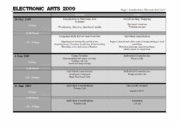Electronic Arts Core Studio 1
This elective is offered from week four through week six and from week thirteen through week fifteen 2009 by The Electronic Arts section in the School of Art at the Otago Polytechnic.
An Introduction to Electronic Arts - Unit 5
SMS Code: VA503001
Directed Learning hours: 25
Level: 5
Credits: 15
Self Directed Learning hours: 25
Total Learning Hours: 50
Lecturer
David Green is a lecturer in time-based media at the School of Art with twenty years experience in the advertising and film industries as a director, visual effects supervisor, and director of photography.
Aims
- To explore basic concepts relating to digital and time-based media within the Electronic Arts context and to begin to use language specific to the field.
- To initiate analysis of moving image, film, video, visual presentation and representation.
- To enable students as artists to initiate investigation, experimentation, and engagement with digital tools in pursuit of a creative concept.
- To engage with a variety of historical and contemporary approaches to the digital still and time-based image.
- To promote and reinforce the understanding of health and safety issues and practices in the digital studio environment.
Learning Outcomes
At the successful completion of this course, students will be able to:
- Begin to apply a conceptual goal to the digital production of time based media.
- Undertake research relevant and specific to digital still and time-based media.
- Begin to articulate some theoretical positions relevant to digital still and time-based media and the student’s own practice.
- Navigate the Windows operating systemand manage digital files.
- Acquire digital still visuals from a variety of sources via scanner or file transfer.
- Use a range of digital tools for manipulating, filtering and editing still images, towards creating motion choreographyfor time-based delivery.
- Competently and creatively engage with Adobe Photoshop and Adobe Premiere software.
- Maintain a research workbook or blog that includes visual, technical, and written documentation relating to digital still andtime-based media within the context of Electronic Arts.
- Transfer a digital copy of finished digital still and time-based work onto DVD disk and upload time-based work to youtube.
Content
- This unit will introduce students to theories and discussions around representation through digital still and time-based media within Electronic Arts.
- Through the creation of conceptually defined projects students will begin togain competence using Adobe Photoshop CS3 (to manipulate digital still images) and Adobe Premiere Pro CS3 (to edit and motion choreograph digital time-based visuals along a soundtrack). This will be achieved through class workshops, demonstrations, screenings, research, discussions and self-directed exercises.
Schedule
Assignment
Using a found assemblage of words as your inspiration, create a montage/mind map,
including both image and text that reflect your intentions for a time-based work
in a still format.
Drawing from an image bank of acquired and scanned digital still image files
of HIGH RESOLUTION (at least 1920 x 1080) use Adobe Photoshop to create an A3 montage
to be in dropbox by Thursday morning (June 4 - week 2 of unit) in order to
be colour laser printed for peer review on Thursday afternoon.
Submission:
Drawing from your selected quotation and cache of image and text
acquired for your still montage, create a set of storyboards,
Download a blank 1:1.33 storyboard template here
and then using Adobe Premiere modulate your source material over time (30-90 Seconds)
to investigate transitional flow relationship through form,
composition, colour, motion, sound and repetition.
To be presented and submitted on Friday afternoon of WEEK 3 of this unit.
Due in Dropbox (V:\EA_DropBox_Stage1_09): 11pm Friday 12 June 2009
Screening: 2:30pm Screening Room
Assessment
Weighting
Practical Application 55%
ConceptualDevelopment 35%
Commitment 10%
The WORKBOOK will form an assessable component within conceptual development.
Resources Required:
Readers are provided as PDF files in your Drive V:\EA_DropBox_Stage1_09.
There is a materials fee of $2 to be collected in class prior to week 2 to cover cost of A3 printing.
Students are expected to provide a blank writeable DVD on the last day of class.
Students are expected to bring visual and audio resources to this course.
Image files
Students are advised to consult with online catalogues for the Bill Robertson and the Otago University libraries as well as the following URL’s:
http://www.fotoscrapix.com/Montage.html
http://www.cutandpaste.info/
http://www.collageart.org/links/
http://www.notcoming.com/saulbass/
http://gimp-savvy.com/PHOTO-ARCHIVE/
http://people.uwec.edu/koroghcm/public_domain.htm
http://www.morguefile.com/archive/
http://photoeverywhere.co.uk/
http://www.everystockphoto.com/
http://www.freeimages.co.uk/
http://www.pics4learning.com/
http://www.pdphoto.org/
http://worldimages.sjsu.edu/
For art works see wikimedia commons:
http://commons.wikimedia.org/wiki/Category:Images (still need to check the copyright statement at the bottom of the image, to make sure it is out of Copryight)
and the web museum http://virgo.bibl.u-szeged.hu/wm/paint/auth/
Sound files
Students are advised to consult with online catalogues for the Bill Robertson and the Otago University libraries as well as the following URL’s:
http://www.soundsnap.com/
http://www.stonewashed.net/free-music.html
Recommended:
The additional readings listed below may provide extension reading for the topics being explored in this unit.
Benjamin, Walter,The Work of Art in the Age of Mechanical Reproduction,
in Hannah Arendt (ed.), Illuminations: Walter Benjamin, trans. Harry Zorn,
London: Pimlico, 1999, pp.211-244.
Giordan, Daniel, The Art of Photoshop,
Sam Publishing, USA, 2003. Kearton, Nicola, ed. Art and Film.
Art and Design Profile No 49, London, 1996.
Larbalestier, Simon, The Art and Craft of Montage,
Mitchell Beazley, London, 1993.
Mirzoeff, Nicholas. An Introduction to Visual Culture,
London: Routledge 1999.
Monaco, James. ‘The Digital Revolution’ in How to Read a Film.
3rd Ed. Oxford University Press, New York and Oxford, 2000: 518 – 534
Woolman, Matt and Bellantoni, Jeff. ‘Type in Motion; Innovation in Digital Graphics’.
New York, Rizzoli, 1999.
Output Specifications
Electronic Arts
PAL
2 seconds bars and tone (1Khz –12dB) - 5 seconds slate - 3 second count down - Submission Content - 2 seconds black
Slate ID is as follows: Name School, Department, and Course ID Work title Duration
For example:
Student Name
Otago School of Art
Electronic Arts
Core Studio 1
FILM TITLE
Length 0:00:30

